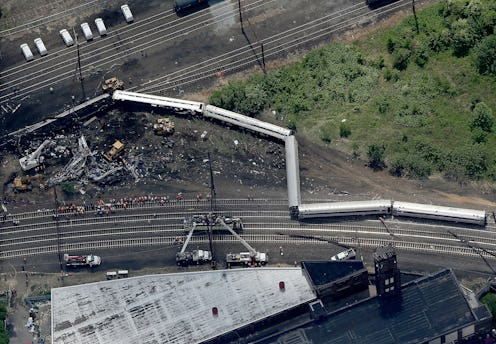News
Amtrak Funding To Be Cut Despite Crash
Just hours after Tuesday’s fatal Amtrak crash that killed at least eight people and injured more than 200, it was announced Amtrak funding would be cut after a House committee passed a bill that would slash the budget for the beleaguered railroad service. The tragic derailment, which occurred around 9 p.m. just outside of Philadelphia, could be seen as a horrifying testament to insufficient federal financial support for Amtrak — and indeed Democratic lawmakers on Capitol Hill argued as much Wednesday, attempting to leverage the disaster to demand an increase in funding. Republicans rejected their appeals, and the House Appropriations committee eventually rebuffed several amendments to a proposed bill that would have boosted Amtrak funding.
The Transportation, Housing and Urban Development Appropriations bill in question lops off nearly $260 million from Amtrak’s current funding level of $1.4 billion, leaving the rail service $1.14 billion. Facing a drastically slashed budget, Democrats proposed amendments that would increase that amount to $2.45 billion (the sum requested by President Barack Obama). Republicans rejected the amendments, defeating the proposal in a 30-21 vote.
Edward G. Rendell, Democratic former governor of Pennsylvania, voiced his disappointment after the vote, saying that a funding increase could have boosted safety by upgrading train tracks and control systems. “It is absolutely stunning to me,” he is quoted by The New York Times as saying. “It shows that ideology trumps reality, and it shows that cowardice reigns in Washington. The callousness and disregard was shockingly contemporaneous.” Investigators report that the derailed Amtrak train was traveling double the speed limit in the lead-up to the crash, but the exact cause of the crash is not yet known.
Regardless, the Democrat’s position was clearly laid out in a statement from North Carolina Democrat David Price, as reported by the Huffington Post. “Yesterday's tragedy in Philadelphia should be a wake-up call to this committee,” Price wrote.
[W]e must provide sufficient funding for Amtrak’s critical infrastructure projects to ensure a safer transportation system… The majority’s short-sighted, draconian budget cuts stand in the way of the investments that a great country must make.
New York Democrat Steve Israel also chimed in, saying that in the wake of the crash, Republican lawmakers should have taken the “opportunity to do the right thing, instead of sticking to their ideology.” But Republicans hit back, accusing their Democratic colleagues of manipulating the tragedy for political gain. “It was beneath you,” Republican Representative Mike Simpson, of Idaho, told a Democratic legislator after the vote, according to the Times.
Republicans, for their part, argued that increasing Amtrak’s budget would be premature, given that the cause of Tuesday’s crash was as yet unknown. Florida Republican Mario Diaz-Balart, chair of the transportation subcommittee, said he had no doubt the derailment would be addressed once its cause was known, but made clear that he didn’t necessarily mean funding would be increased at that time. Diaz-Balart scathingly rejected the idea that “it is always, no matter what, more money that is the solution.”
In Amtrak’s case, though, more money really might be the answer to increasing the safety of an outdated transport network. The Times reports that Amtrak’s Northeast Corridor is the nation’s biggest rail thoroughfare, but that bridges and tunnels in this section are hopelessly antiquated and in desperate need of replacement, while sections of the track still sport wooden ties (the track’s perpendicular support slats). A collective editorial from the Times highlights the almost ludicrous nature of Amtrak’s proposed budget, when looking at the very real costs repairs would incur. Experts estimated in April that it would take $21.1 billion just to carry out necessary maintenance in the Northeast Corridor — repairing and replacing “existing assets” that have passed their prime.
This sum doesn’t take into account new stations, expansion, or, indeed, updated safety equipment. The Times notes that one such safety tool, a positive train control system, is designed to slow a train automatically as it enters a sharp corner. Such a system could certainly have mitigated Tuesday’s disaster, in which the train came off the rails after an acute left-hand turn. Although Amtrak has installed some components of this control system, the network is not yet in action, according to Reuters. A rail safety law passed in 2008 stipulates that railroads must be equipped with this technology, but most railroads are reportedly likely to miss that target.
The Christian Science Monitor notes that a 2013 Northeast Corridor Infrastructure and Operations Advisory Commission found that an increase in funding would be of fundamental importance to keeping the system safe and efficient. The commission wrote:
Today, the reality is that after four decades of limited federal, state, and local investment, deferring replacement of key components of the NEC is no longer a sustainable option – infrastructure inherited from past generations can no longer provide the mobility needed to support continued, robust economic growth… New investment is essential to modernize systems, reduce failures, and expand capacity for increased service.
The commission also noted that while funding stagnated, Amtrak’s ridership was growing. Between 2001 and 2011, the portion of air and rail travelers using Amtrak between Washington and New York increased from 37 percent to 75 percent. In 2014, according to the Times, the number of passengers hit 32 million. And yet, in the same year, Amtrak lost $1 billion with revenue of $3.2 billion. “I think we have a slow process going in the right direction,” Ross Capon, who ran the National Association of Railroad Passengers for four decades, told The Washington Post. “The ridership has set records, growing substantially while the politicians fight over whether [Amtrak] should exist."
But Tuesday’s crash makes one wonder — how long will people be willing to ride on rickety trains, if partisan bickering ensures insufficient funding to guarantee their safety?
Images: Getty Images (4)
